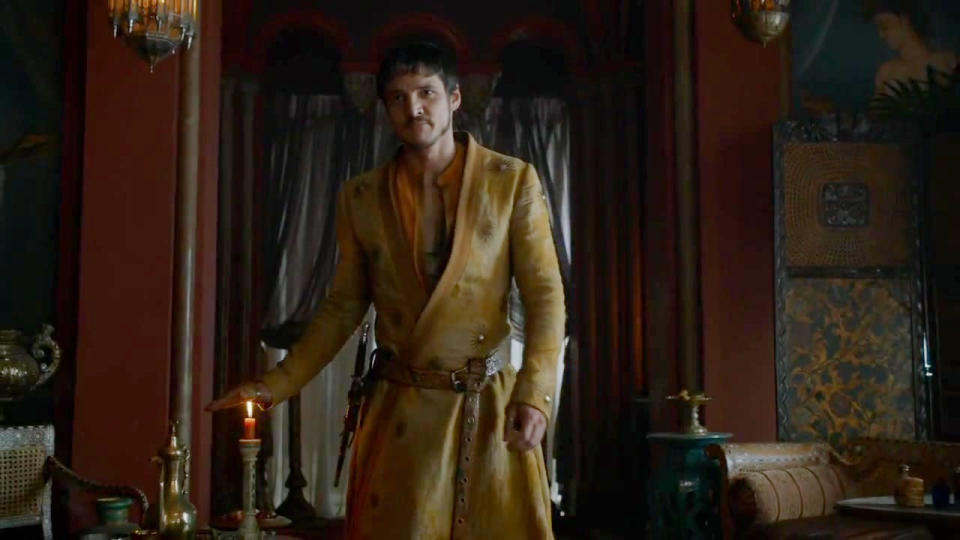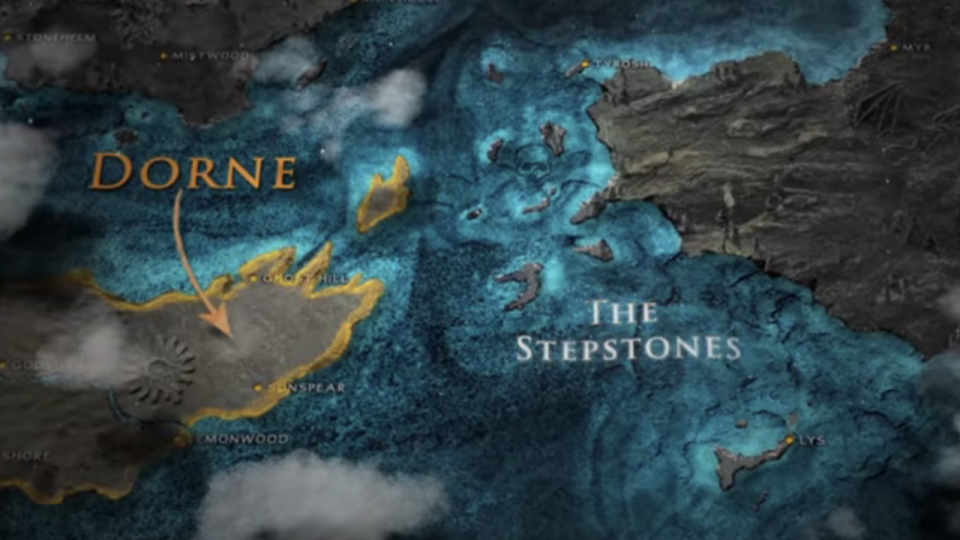After New Details About Game Of Thrones’ Scrapped 10,000 Ships Spinoff, Here’s How Faithful It Would Have Been To George R.R. Martin’s Source Material

- Oops!Something went wrong.Please try again later.
- Oops!Something went wrong.Please try again later.
The Game of Thrones action on the way next is House of the Dragon Season 2, but new details have emerged about a different project to tide fans over until the return in the 2024 TV schedule. One spinoff previously in development as an upcoming Game of Thrones show was called 10,000 Ships and would have told the story of Nymeria, whose ways were engrained in Dornish society by the time of Oberyn Martell.
That project isn't currently moving forward, but one writer detailed what it would have been about, and I consulted author George R.R. Martin's source material to see just how faithful it would have been to his lore.

What 10,000 Ships Would Have Been About
Writer Brian Helgeland recently opened up about the plans for the 10,000 Ships series when speaking with Inverse, saying that he thinks the reason that HBO didn't move forward with it is because "they felt the period of my show was too far removed from the pillars of the original," although he noted that "nothing is ever dead." He went on to describe the plan he had for the spinoff:
My script was based on Queen Nymeria and this little blurb about her that was in a Westeros encyclopedia. Essentially, it was the story of Moses but swapping him out for Nymeria. Her country gets ruined and her people are forced to live on the water, which is why the show was called Ten Thousand Ships. They end up having to leave and find a new home like the Israelites leaving Egypt. She’s leading all these people, trying to hold everyone together but things are always in danger of falling apart as they travel around a fictionalized version of the Mediterranean, looking for a new home to settle in.
In true Game of Thrones style, traveling around in search of a new home wouldn't be straightforward or easy, and I'd say that even imagining the visuals of her floating band of refugees is pretty incredible. The writer continued:
Their life was nomadic. Living in a raft city that was bound together, this big floating city. Sometimes, the characters would come ashore, but they ultimately get driven off the land as they search for a home, their version of the promised land.
The writer went on to share that he'd met with A Song of Ice and Fire author George R.R. Martin about the premise, saying that Martin "signed off on" it, but wasn't able to work with him closer since the show wasn't picked up.
Helgeland didn't name the ASOIAF encyclopedia that gave him the "little blurb" about Nymeria, but I decided to consult my handy copy of The World of Ice & Fire: The Untold History of Westeros and the Game of Thrones, by George R.R. Martin, to see how accurate the writer's description was to Martin's canonical legend.

What George R.R. Martin Tells Us About Nymeria
Like the fictional history book Fire & Blood that is the source material for House of the Dragon, The World of Ice & Fire is an in-universe history tome, penned by Maester Yandel for King Tommen around the era of the fifth A Song of Ice and Fire book. (Yes, that Tommen.) In it, George R.R Martin tells the story of the people who lived along the river Rhoyne many, many years before the Game of Thrones era, who fought against the Valyrians and were defeated after "three hundred or more" dragons entered the fray.
Princess Nymeria, who hadn't wanted to wage an unwinnable war against the Valyrians in the first place, acted before her own city met the same fate as other Rhoynish settlements. As Yandel, George R.R. Martin writes:
The same fate awaited her own city, she saw. Accordingly, she gathered every ship that remained upon the Rhoyne, large or small, and filled them full of as many women and children as they could carry (for almost all the men of fighting age had marched with Garin, and died). Down the river Nymeria led this ragged fleet, past ruined and smoking towns and fields of the dead, through waters choked with bloated, floating corpses.
That's certainly sounds like a story fit for a Game of Thrones spinoff! Brian Helgeland didn't exactly get into the "bloated, floating corpses" when describing what he'd read about Nymeria, and I have to wonder if 10,000 Ships would have shown much of the war that sent the Rhoynish princess on her journey across the water. The World of Ice & Fire continues:
Legend tells us that Nymeria took ten thousand ships to sea, searching for a new home for her people beyond the long reach of Valyria and its dragonlords. Beldecar argues that this number was vastly inflated, perhaps as much as tenfold. Other chroniclers offer other numbers, but in truth no true count was ever made. We can safely say there were a great many ships. Most were river craft, skiffs and poleboats, trading galleys, fishing boats, pleasure barges, even rafts, their decks crammed full of women and children and old men. Only one in ten was remotely seaworthy.
The story of Nymeria and her ten thousand ships is a little less glorious when considering that they weren't thousands upon thousands of mighty warships at her command, but that element of the story makes it easy to understand why the writer compared her story to that of Moses from the Old Testament of the Bible. Via The World of Ice and Fire, George R.R. Martin continues:
Nymeria's voyage was long and terrible. More than a hundred ships foundered and sank in the first storm her fleet encountered. As many or more turned back in fear, and were taken by slavers out of Volantis. Others fell behind or drifted away, never to be seen again.
The scrapped spinoff writer's comments about the characters coming ashore to try and find their "promised land" connect to what is explained in more detail in the book. To get into some lore, Martin says in the history book that Nymeria and her people arrived first at the Basilisk Isles, with disaster befalling them again on Ax Island and the Island of Toads. Then, they tried the continent of Sothoryos, the island of Naath, and the Summer Isles before sailing for Westeros... and eventually arriving in Dorne.
And if it wasn't clear by the fact that Aegon's coronation in House of the Dragon included "King of the Andals and the Rhoynar and the First Men," Nymeria and her Rhoynish survivors' arrival in Dorne stuck. She famously burned her 10,000 ships after settling in what would later become one of the Seven Kingdoms, leaving Dorne with a different set of customs from the rest of Westeros.

Would 10,000 Ships Have Worked As A Series?
As somebody who initially doubted that the story of Nymeria really had enough substance to fuel an ongoing series, I'm glad that I revisited what George R.R. Martin wrote in The World of Ice & Fire. While the book may not be about Nymeria and the very early days of Dorne, there's enough in the source material to set up a pretty great premise for a TV show, but not so much that there wouldn't be room for writers to go explore new directions.
Besides, George R.R. Martin's world is about more than Targaryens and the Iron Throne, and it'd be great to see that via the Nymeria lore. Just imagine how much less incest there could be in 10,000 ships as opposed to House of the Dragon and even The Hedge Night, given that the latter is set before the fall of the Targaryen dynasty!
Of course, I'd be even more glad if HBO changed tunes and gave 10,000 ships a chance. Any reader of Fire & Blood can guess that House of the Dragon won't be running for eight seasons a la Game of Thrones, and The Hedge Knight – which just cast the two lead roles – draws from a very different kind of source material. 10,000 Ships could be something fresh, new, and pretty epic.
For now, fans of the world of Westeros can look forward to the arrival of House of the Dragon Season 2 in June, rewatch Game of Thrones streaming via Max subscription, and/or try to hold out hope that George R.R. Martin will finish The Winds of Winter one of these days as the sixth A Song of Ice and Fire novel.

